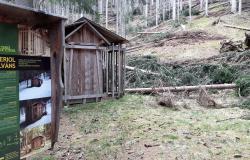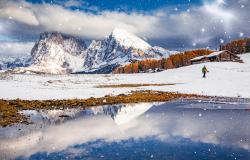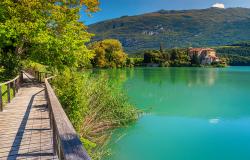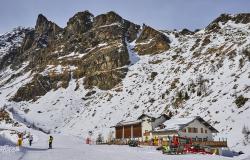The Strada Statale 48 delle Dolomiti (SS 48 - State Road of the Dolomites), also known as the Great Dolomites Road, is a scenic mountain road that runs through the Dolomites, built between 1901 and 1909 to connect the city of Bolzano in Alto Adige (South Tyrol) to Cortina d’Ampezzo in Veneto, passing by beautiful mountain landscapes and such iconic peaks and groups as the Catinaccio, Tofane, Marmolada, Lagazuoi and Sella.
The History of the Grande Strada delle Dolomiti
On 13 September, 1909, the section of the Strada delle Dolomiti between the towns of Arabba and Cortina was inaugurated. The event was celebrated by media in all of Europe and the United States, described as one of the greatest engineering feats of the new century.
With the opening of this section, the Great Dolomites Road project, which had begun in 1901, was completed. The road made it easier to access the heart of the Dolomites by connecting some of the major towns and resorts of the area - Bolzano, Fassa, Livinallongo and Cortina - and by opening several mountain passes, which until then had represented considerable obstacles.

The Dolomites became a tourist attraction as early as the second half of the 19th century; by the beginning of the 20th century, some of the most famous and luxurious hotels in Cortina and Canazei had been built.
World War I put a temporary halt to the tourist development of the Dolomites, as the road intersected the frontline; indeed, the road itself was used for war purposes.
But it was also thanks to the road that it was possible to relaunch tourism in the area in the post-war years. As tourism increased, so grew the towns and valleys touched by the road, changing their way of life to a new economy based on tourism.
The Route Today
The Great Dolomites Road is 145 km long and is an ideal way to discover the Dolomites, a Unesco World Heritage site, taking detours to go on hikes and discover the local culture. It begins in the small town of Cardano, but we recommend you begin in nearby Bolzano, where, before setting off, you should visit the town’s historic center, with the central Piazza Walther, the arcaded streets of via della Mostra, via dei Bottai and via dei Portici, and the Cathedral in typical Tyrolean Gothic style. Also, you may want to make a detour to the Renon plateau.
In Cardano, the Great Dolomites Road branches off from the Abetone and Brenner State Road 12 to cross the Val d'Ega through a tunnel and reach Nova Levante, where you can enjoy a splendid view of the Catinaccio group, part of the Sciliar-Catinaccio Nature Park. A short distance away and worthy of a stop is Lake Carezza, with its crystal waters in which the imposing Latemar massif is reflected.
From here the road climbs to the Costalunga pass, whose opposite side opens onto the Val di Fassa, the heart of the Ladin traditions of Trentino-Alto Adige (Ladin is an ancient culture that is unique to the Dolomites; the Ladin people have their own language, traditions and even their own cuisine), with the towns of Vigo, Pozza, Pera and Campitello of Fassa. At the northern end of the valley is the beautiful ski resort of Canazei. Val di Fassa is one of the main valleys of the Dolomites, and one of the most popular too.

The SS48 continues to the Pordoi pass, which marks the border with the Veneto region; from here, you can enjoy a breathtaking view of the Marmolada glacier, the Sass Pordoi and Sassolungo.
On the other side of the pass, in the province of Belluno, you reach Arabba. Located at the foot of the Sella group, Arabba is the main resort town of the Valley of Fodom, one of five Ladin valleys of the Dolomites. Arabba is a favorite destination for summer hiking and mountain biking thanks to its proximity to many famous groups, peaks and valleys of the Dolomites, such as the Sella group, the Marmolada, Col di Lana, the Alta Badia valley, and the Lagazuoi-5 Torri area, among others.
Continuing along the Great Dolomites Road, you reach Corte, from which you can admire the small village of Andraz and the unique profile of its castle, which rises up on a rocky spur and is thought to date back to the 11th century.
Once you reach the Falzarego pass, you can choose to hike or to take the cable car up to the Lagazuoi mountain hut, which offers a superb view. This is also a sort of open-air museum for the large number of trenches and military fortifications found on the surrounding ridges, dating back to World War I. During World War I, the Lagazuoi mountain was located in the central section of the Dolomites front, where the Italian troops and the Kaiserjager (Austrian soldiers) confronted each other in the midst of a hostile Alpine environment.

Beyond Falzarego is Cortina d'Ampezzo, known as the pearl of the Dolomites, home to the 1956 Winter Olympic Games; the town is scheduled to host them again in 2026.
The road then continues following the course of the Ansiei stream to Lake Misurina, Auronzo di Cadore up to the hamlet of Cima Gogna, where it ends.









